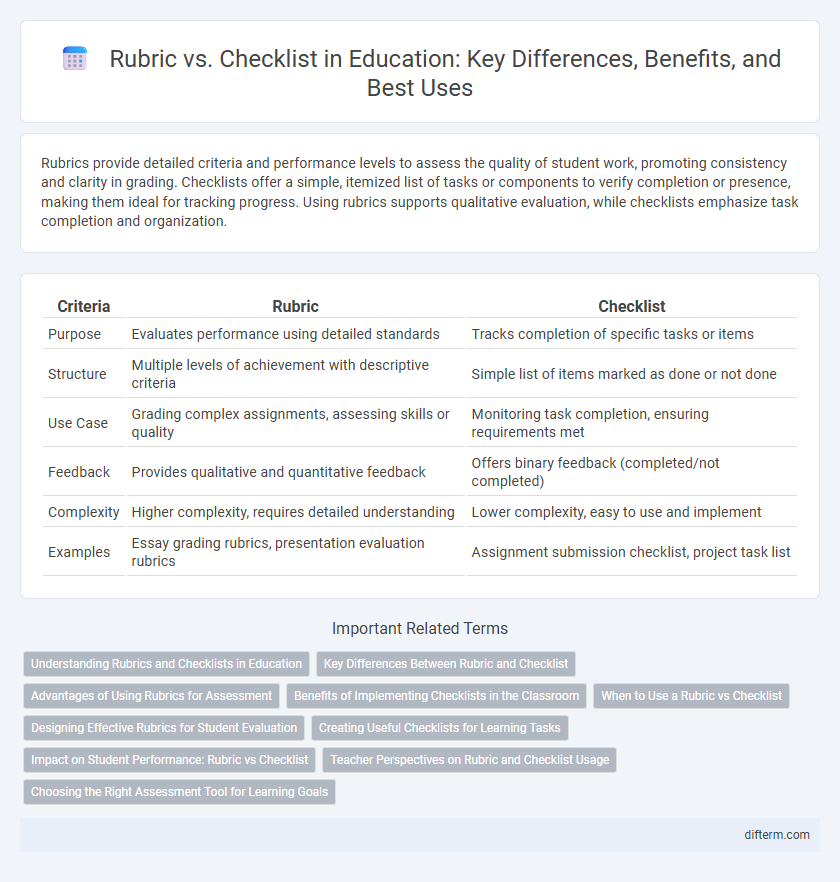Rubrics provide detailed criteria and performance levels to assess the quality of student work, promoting consistency and clarity in grading. Checklists offer a simple, itemized list of tasks or components to verify completion or presence, making them ideal for tracking progress. Using rubrics supports qualitative evaluation, while checklists emphasize task completion and organization.
Table of Comparison
| Criteria | Rubric | Checklist |
|---|---|---|
| Purpose | Evaluates performance using detailed standards | Tracks completion of specific tasks or items |
| Structure | Multiple levels of achievement with descriptive criteria | Simple list of items marked as done or not done |
| Use Case | Grading complex assignments, assessing skills or quality | Monitoring task completion, ensuring requirements met |
| Feedback | Provides qualitative and quantitative feedback | Offers binary feedback (completed/not completed) |
| Complexity | Higher complexity, requires detailed understanding | Lower complexity, easy to use and implement |
| Examples | Essay grading rubrics, presentation evaluation rubrics | Assignment submission checklist, project task list |
Understanding Rubrics and Checklists in Education
Rubrics in education provide detailed criteria that describe different levels of performance, facilitating objective assessment of student work and promoting consistent grading. Checklists serve as straightforward tools to ensure the completion of required tasks or components, enhancing organization and accountability. Both rubrics and checklists support formative assessment by clarifying expectations and guiding self-evaluation.
Key Differences Between Rubric and Checklist
Rubrics provide detailed criteria with varying levels of performance quality, allowing educators to assess complex skills and assign nuanced scores, whereas checklists offer a simple binary evaluation indicating whether specific tasks or requirements were met. Rubrics facilitate qualitative feedback by outlining expectations and standards for each criterion, while checklists primarily track the completion of individual components without addressing the depth or quality of work. The use of rubrics enhances consistency and transparency in grading subjective assignments, contrasting with the straightforward, task-focused verification that checklists provide.
Advantages of Using Rubrics for Assessment
Rubrics provide clear criteria and detailed performance levels that enhance consistency and objectivity in student assessment. They facilitate targeted feedback by highlighting specific areas of strength and improvement, promoting deeper learning and self-reflection. Rubrics also streamline grading efficiency while supporting transparent communication of expectations between educators and students.
Benefits of Implementing Checklists in the Classroom
Implementing checklists in the classroom enhances student organization and ensures consistent task completion by providing clear, step-by-step guidance. Checklists facilitate self-assessment and promote student accountability, helping learners track their progress and identify areas for improvement. Educators benefit from streamlined grading and improved communication of expectations, leading to more efficient classroom management and better learning outcomes.
When to Use a Rubric vs Checklist
Use a rubric when detailed assessment criteria with performance levels are needed to evaluate complex skills or projects, providing qualitative feedback and guiding student improvement. Employ a checklist for simpler tasks requiring verification of completed steps or specific elements, ensuring accuracy and completeness without subjective judgment. Rubrics enhance learning in assignments involving critical thinking or creativity, while checklists streamline routine or procedural evaluations.
Designing Effective Rubrics for Student Evaluation
Designing effective rubrics for student evaluation involves clearly defining performance criteria and levels of achievement to ensure consistent and objective assessment. Unlike checklists that simply verify task completion, rubrics provide detailed descriptions of quality, guiding students toward specific learning goals and improvement. Incorporating measurable indicators and aligned learning outcomes enhances the rubric's ability to support both formative and summative assessments in educational settings.
Creating Useful Checklists for Learning Tasks
Creating useful checklists for learning tasks involves breaking down complex assignments into clear, manageable steps that guide students through each phase of their work. Unlike rubrics that assess quality based on specific criteria, checklists emphasize task completion and help learners stay organized, track progress, and reduce cognitive load. Effective educational checklists enhance task clarity and promote consistent, independent learning habits.
Impact on Student Performance: Rubric vs Checklist
Rubrics provide detailed criteria and performance levels, helping students understand expectations and self-assess their work, which leads to improved learning outcomes and higher-quality submissions. Checklists offer a straightforward task completion guide, ensuring that students meet basic requirements but may lack depth in feedback on the quality of work. Research indicates that rubrics have a stronger positive impact on student performance by promoting critical thinking and deeper engagement compared to checklists.
Teacher Perspectives on Rubric and Checklist Usage
Teachers often prefer rubrics for their detailed criteria that provide clear performance standards, facilitating more consistent and objective grading. Checklists are favored for their simplicity and ease of use, helping educators quickly track task completion without evaluating quality. Both tools support formative assessment, with rubrics enhancing feedback depth and checklists streamlining task management in classroom settings.
Choosing the Right Assessment Tool for Learning Goals
Selecting the appropriate assessment tool depends on learning objectives and desired feedback depth; rubrics provide detailed criteria and performance levels ideal for complex skills evaluation, while checklists offer straightforward task completion verification suited for procedural or binary outcomes. Rubrics enhance qualitative insights by identifying areas of strength and improvement, facilitating targeted instruction and self-assessment. Checklists streamline tracking of step-by-step competencies, promoting efficiency in formative assessments and routine skill checks.
Rubric vs Checklist Infographic

 difterm.com
difterm.com